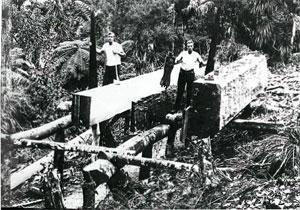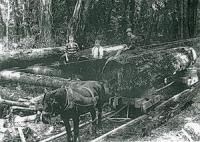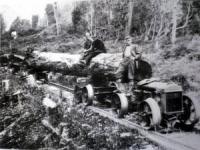Clearing the bush
Motu is noted for its high altitude and big trees. Probably some of the best milling in New Zealand came from Motu. Predominant trees being; rimu, matai, and kahikatea, (white pine). Millions of tonnes of timber were chopped down and burned, wasted to make way for farming.
The first trees were cut down with an axe and a long cross-cut saw, and then logs were split with a maul and wedge into slabs and used to make dwellings.
(Pit saw picture)
This was followed by the pit sawing. The log was dragged over the pit and two men operated a long sharp saw with one man on the top and the other one in the pit.
Experienced men could produce several hundred super feet a day.
Over the years 11 timber mills have been registered in the Motu/Motuhora district.
The first one was in 1901 registered to Granfield and Patterson followed by Hansens steam sawmill, then others like Quirks, Halls, McDonalds, Peddles and Lloyds when the railway was complete.
After the trees were cut down by the bushmen, the logs were dragged out of the bush by teams of bullocks. Tram lines were constructed from the skids to the mills and teams of horses or bullocks pulled wagons of logs or sawn timber on the tram lines to the mills or to the railway station.
In 1920 alone, three timber mills produced 14,390 tonnes of timber which was sent to Gisborne by rail. By 1940 most of the easily accessible timber had been cut out, the mills closed and many people moved away.
By Allan








